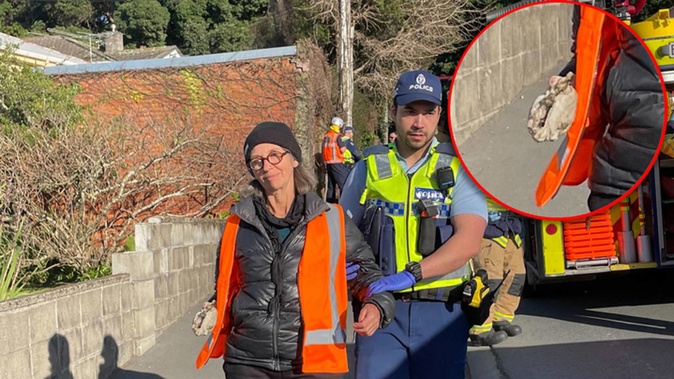
A protester who stuck her hand to a main Wellington road with a cement-like substance is fighting to be given an ankle bracelet instead of spending the next two weeks in a prison cell.
Rosemary Penwarden, 64, was remanded in custody yesterday after allegedly endangering transport on State Highway 1 in Kilbirnie.
She is the only one out of multiple fellow protesters to be declined bail, and is now appealing to the High Court to be put on electronically-monitored bail.
Penwarden, a member of the Restore Passenger Rail group, is accused of blocking morning rush-hour traffic on the road as part of a series of protests calling for inter-regional passenger rail services, free public transport, and action on climate change.
/cloudfront-ap-southeast-2.images.arcpublishing.com/nzme/53IXBHDRFFAVDGHDXBI3AG6TKY.png) A Restore Passenger Rail protester at an earlier protest is dragged away by police after blocking Glenmore St in Karori. Photo / Azaria Howell
A Restore Passenger Rail protester at an earlier protest is dragged away by police after blocking Glenmore St in Karori. Photo / Azaria Howell
She and two other protesters were arrested yesterday morning, but her two co-accused were released on bail. Penwarden was remanded in custody until her next appearance on September 11.
One of Penwarden’s lawyers, Seth Fraser, confirmed they were appealing the bail decision, and expected the bail hearing to happen soon.
“Meanwhile, how many tens of thousands of emperor penguins have died because Antarctica’s shrunk?” he said.
Fraser said if there needed to be a law that protesters could not block traffic, then that should come from Parliament.
Penwarden was photographed leaving the scene of the protest with a hard substance encasing her hand - which another protester said was “cement”. She appeared in the Wellington District Court yesterday afternoon by audio visual link from Wellington Hospital, where she could be seen with her hand in a bucket.
- Traffic disruption warning by police ahead of Restore Passenger Rail protest
- Police stop Restore Passenger Rail protest before it starts, one in custody
- 'Just trying to feed my kids': Wellingtonians unleash on protesters blocking busy street
- Restore Passenger Rail protester: We'll continue to push for action
But a construction expert said it was more likely an epoxy-type substance, as even quick-set cement took an hour or two to become hard enough to trap someone’s hand on the road.
“Cement is a very dangerous thing,” said AUT’s John Tookey. “Most of these protesters . . . use an epoxy.”
Globally, protesters have used a mixture of epoxy resin with cement to stick themselves to surfaces.
Tookey said epoxy would create an exothermic reaction that could cause burns to the skin, but could eventually be peeled away as the top layer of skin died. The hand could be soaked in the meantime.
“Most of the adhesives, they have an exothermic reaction. When the two components come together, when they react they give off heat. You end up having to cool them down with cold water in the first instance so they don’t physically burn full thickness through the skin.”
He said long-term exposure to the skin could cause dermatitis.
Melissa Nightingale is a Wellington-based reporter who covers crime, justice and news in the capital. She joined the Herald in 2016 and has worked as a journalist for 10 years.
Take your Radio, Podcasts and Music with you









